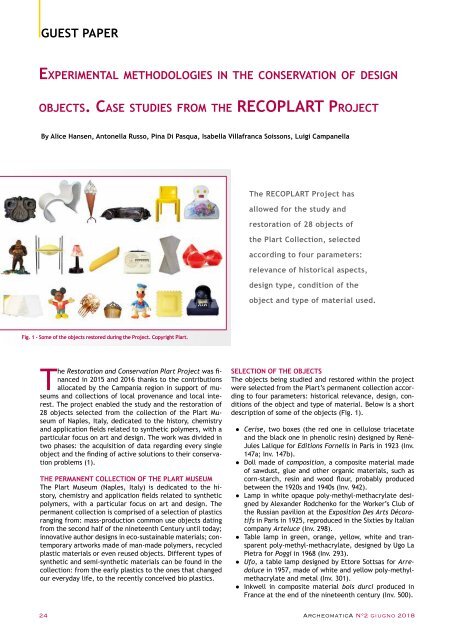Archeomatica_2_2018
Tecnologie per i Beni Culturali
Tecnologie per i Beni Culturali
You also want an ePaper? Increase the reach of your titles
YUMPU automatically turns print PDFs into web optimized ePapers that Google loves.
GUEST PAPER<br />
Experimental methodologies in the conservation of design<br />
objects. Case studies from the RECOPLART Project<br />
By Alice Hansen, Antonella Russo, Pina Di Pasqua, Isabella Villafranca Soissons, Luigi Campanella<br />
The RECOPLART Project has<br />
allowed for the study and<br />
restoration of 28 objects of<br />
the Plart Collection, selected<br />
according to four parameters:<br />
relevance of historical aspects,<br />
design type, condition of the<br />
object and type of material used.<br />
Fig. 1 - Some of the objects restored during the Project. Copyright Plart.<br />
The Restoration and Conservation Plart Project was financed<br />
in 2015 and 2016 thanks to the contributions<br />
allocated by the Campania region in support of museums<br />
and collections of local provenance and local interest.<br />
The project enabled the study and the restoration of<br />
28 objects selected from the collection of the Plart Museum<br />
of Naples, Italy, dedicated to the history, chemistry<br />
and application fields related to synthetic polymers, with a<br />
particular focus on art and design. The work was divided in<br />
two phases: the acquisition of data regarding every single<br />
object and the finding of active solutions to their conservation<br />
problems (1).<br />
THE PERMANENT COLLECTION OF THE PLART MUSEUM<br />
The Plart Museum (Naples, Italy) is dedicated to the history,<br />
chemistry and application fields related to synthetic<br />
polymers, with a particular focus on art and design. The<br />
permanent collection is comprised of a selection of plastics<br />
ranging from: mass-production common use objects dating<br />
from the second half of the nineteenth Century until today;<br />
innovative author designs in eco-sustainable materials; contemporary<br />
artworks made of man-made polymers, recycled<br />
plastic materials or even reused objects. Different types of<br />
synthetic and semi-synthetic materials can be found in the<br />
collection: from the early plastics to the ones that changed<br />
our everyday life, to the recently conceived bio plastics.<br />
SELECTION OF THE OBJECTS<br />
The objects being studied and restored within the project<br />
were selected from the Plart’s permanent collection according<br />
to four parameters: historical relevance, design, conditions<br />
of the object and type of material. Below is a short<br />
description of some of the objects (Fig. 1).<br />
● Cerise, two boxes (the red one in cellulose triacetate<br />
and the black one in phenolic resin) designed by Renè-<br />
Jules Lalique for Editions Fornells in Paris in 1923 (Inv.<br />
147a; Inv. 147b).<br />
● Doll made of composition, a composite material made<br />
of sawdust, glue and other organic materials, such as<br />
corn-starch, resin and wood flour, probably produced<br />
between the 1920s and 1940s (Inv. 942).<br />
● Lamp in white opaque poly-methyl-methacrylate designed<br />
by Alexander Rodchenko for the Worker’s Club of<br />
the Russian pavilion at the Exposition Des Arts Décoratifs<br />
in Paris in 1925, reproduced in the Sixties by Italian<br />
company Arteluce (Inv. 298).<br />
● Table lamp in green, orange, yellow, white and transparent<br />
poly-methyl-methacrylate, designed by Ugo La<br />
Pietra for Poggi in 1968 (Inv. 293).<br />
● Ufo, a table lamp designed by Ettore Sottsas for Arredoluce<br />
in 1957, made of white and yellow poly-methylmethacrylate<br />
and metal (Inv. 301).<br />
● Inkwell in composite material bois durci produced in<br />
France at the end of the nineteenth century (Inv. 500).<br />
24 ArcheomaticA N°2 giugno <strong>2018</strong>


















